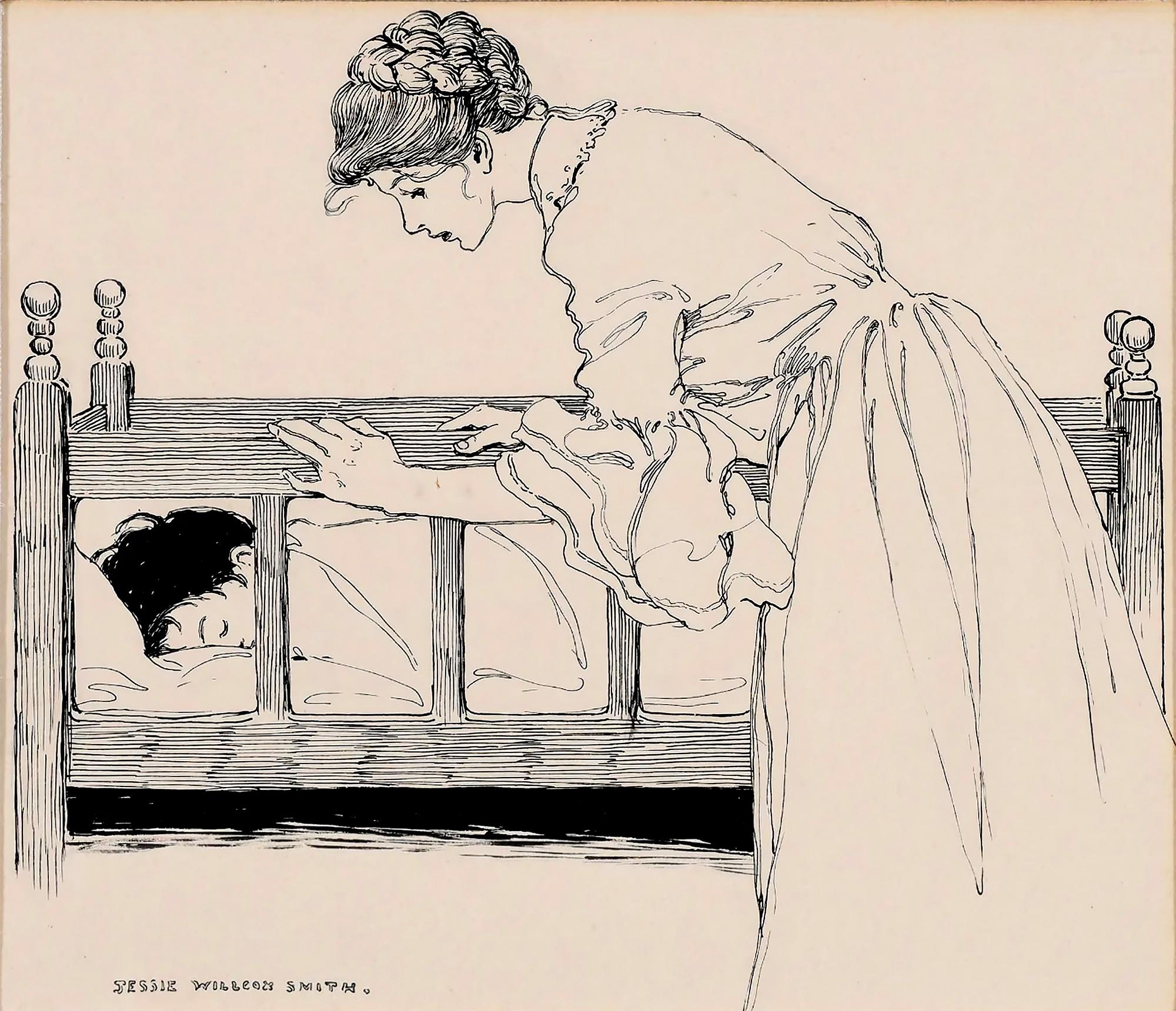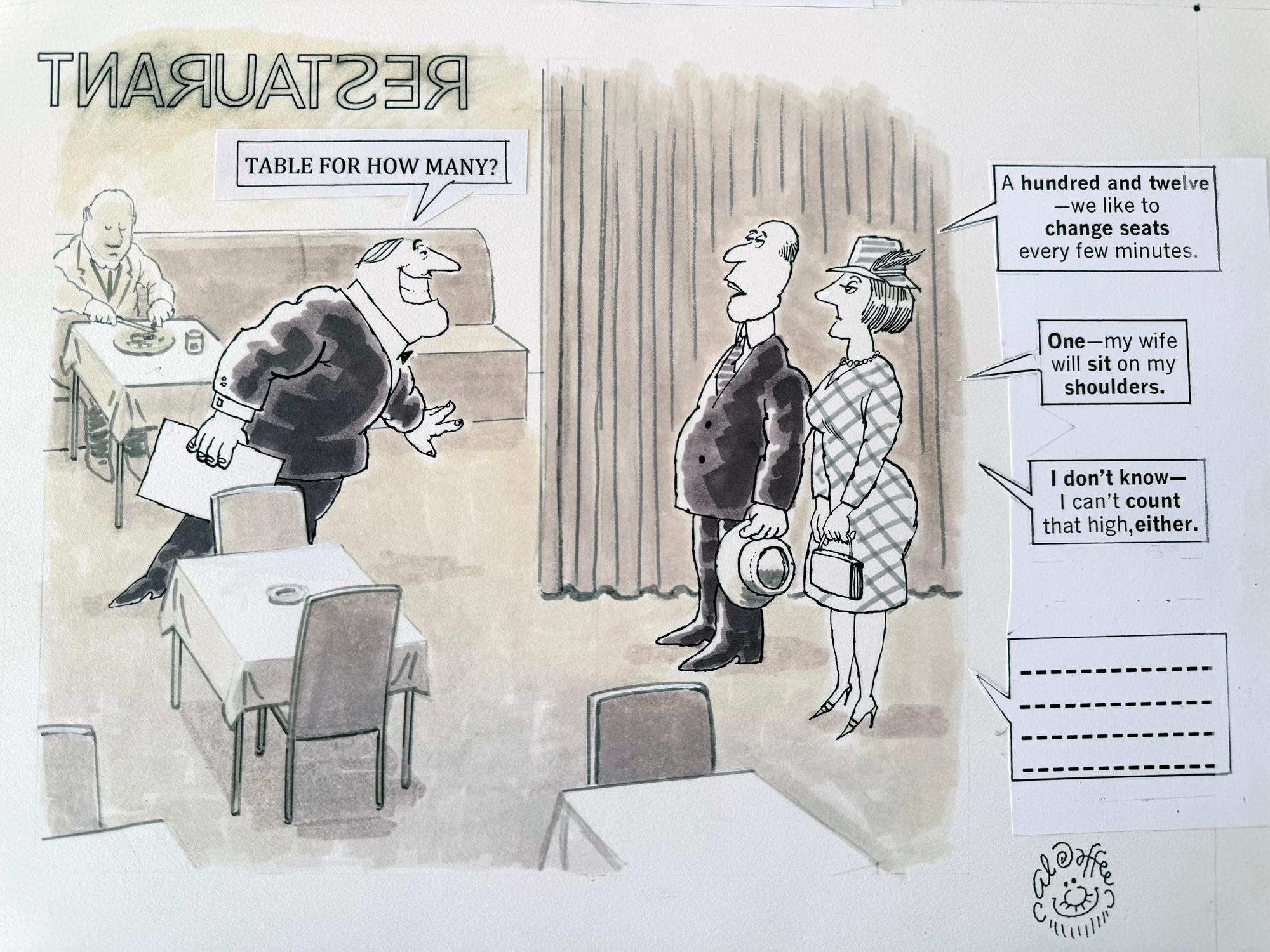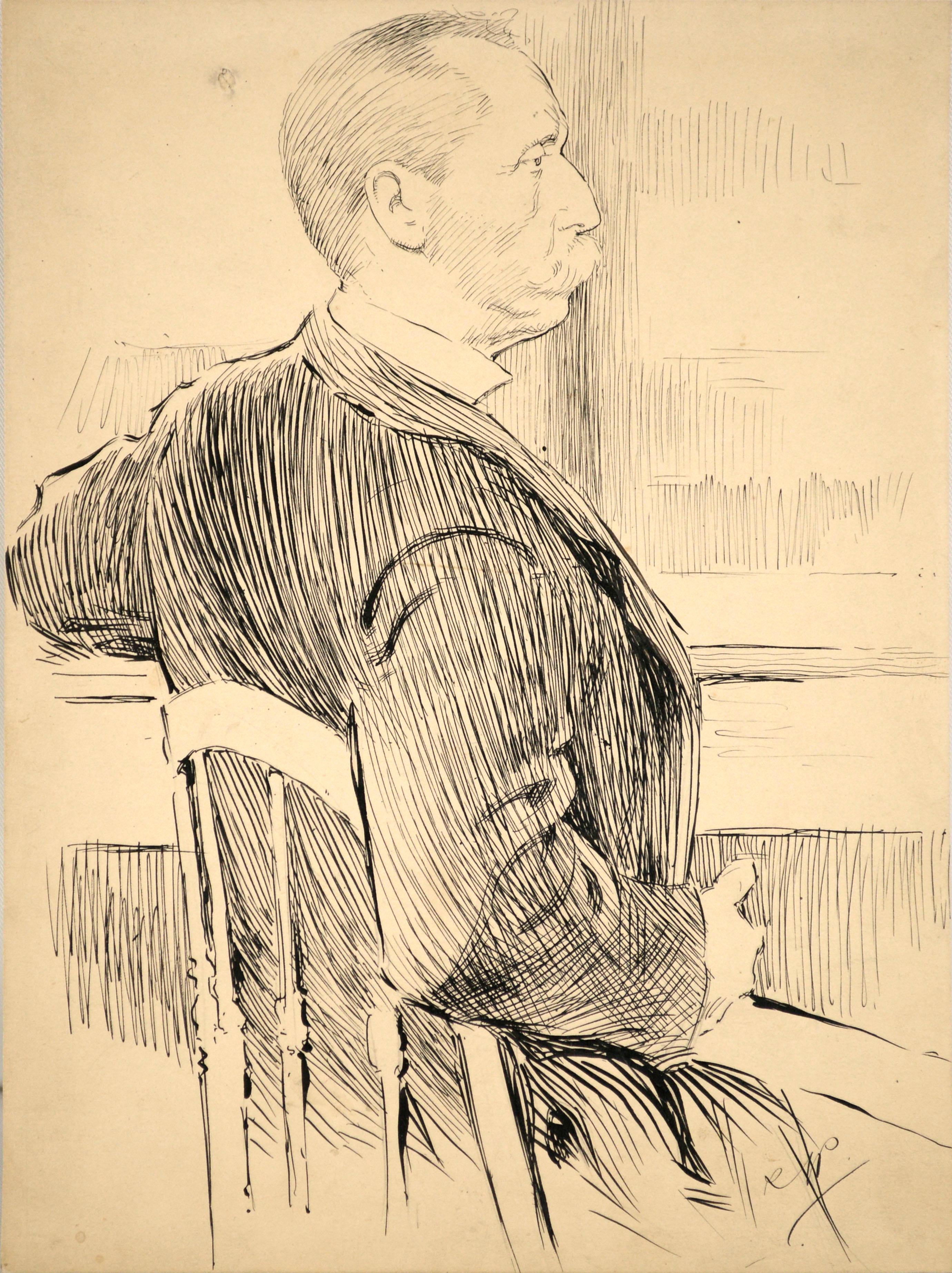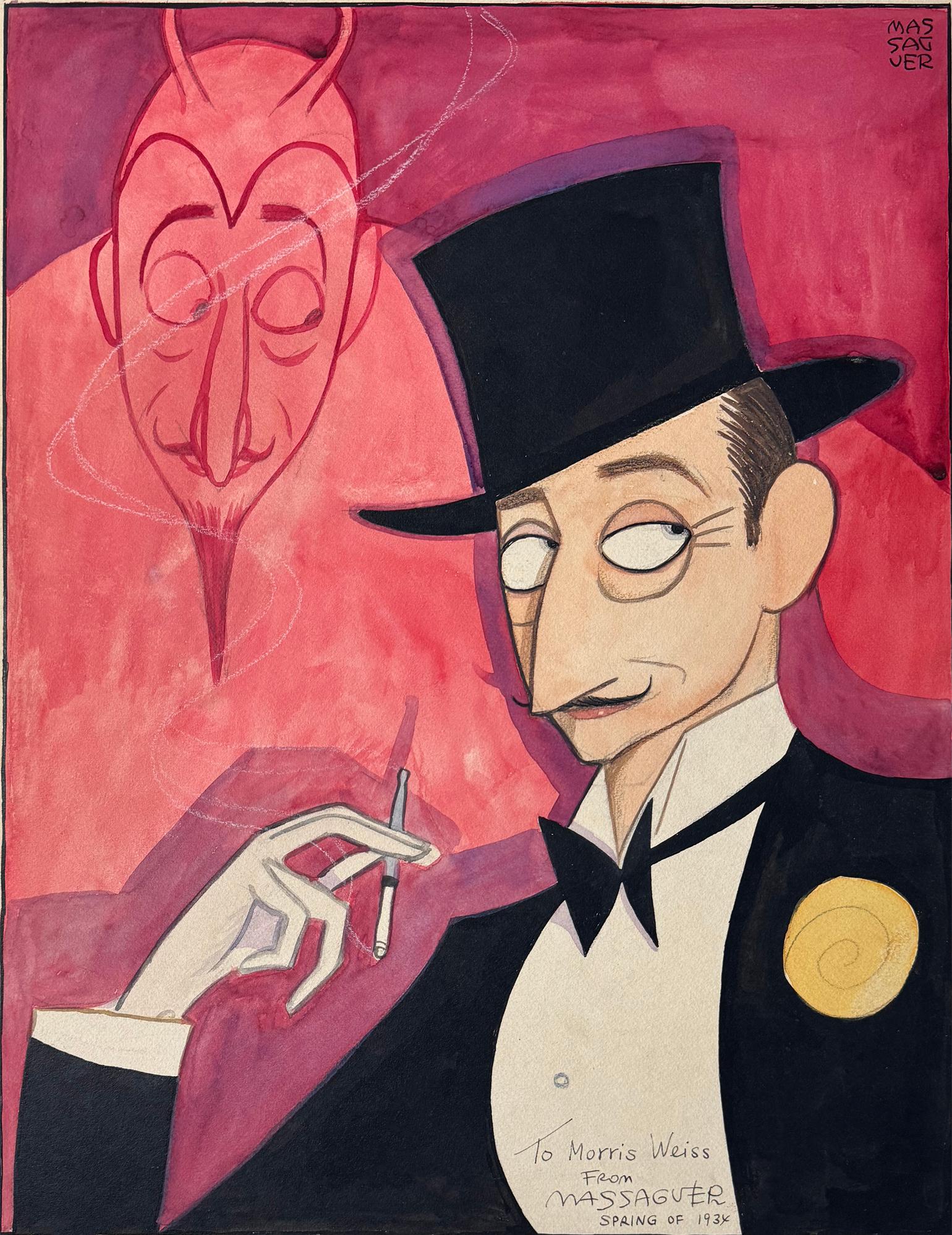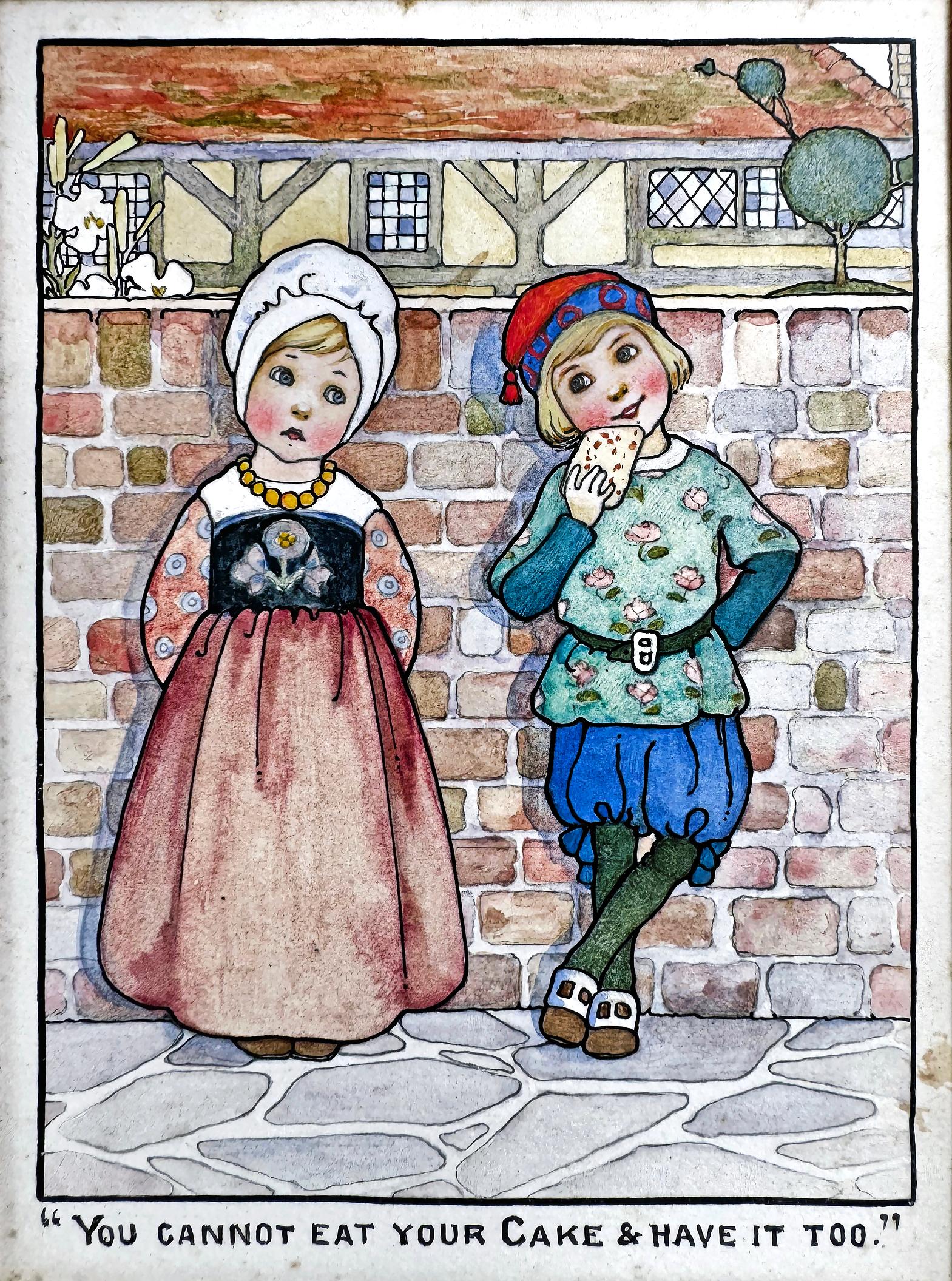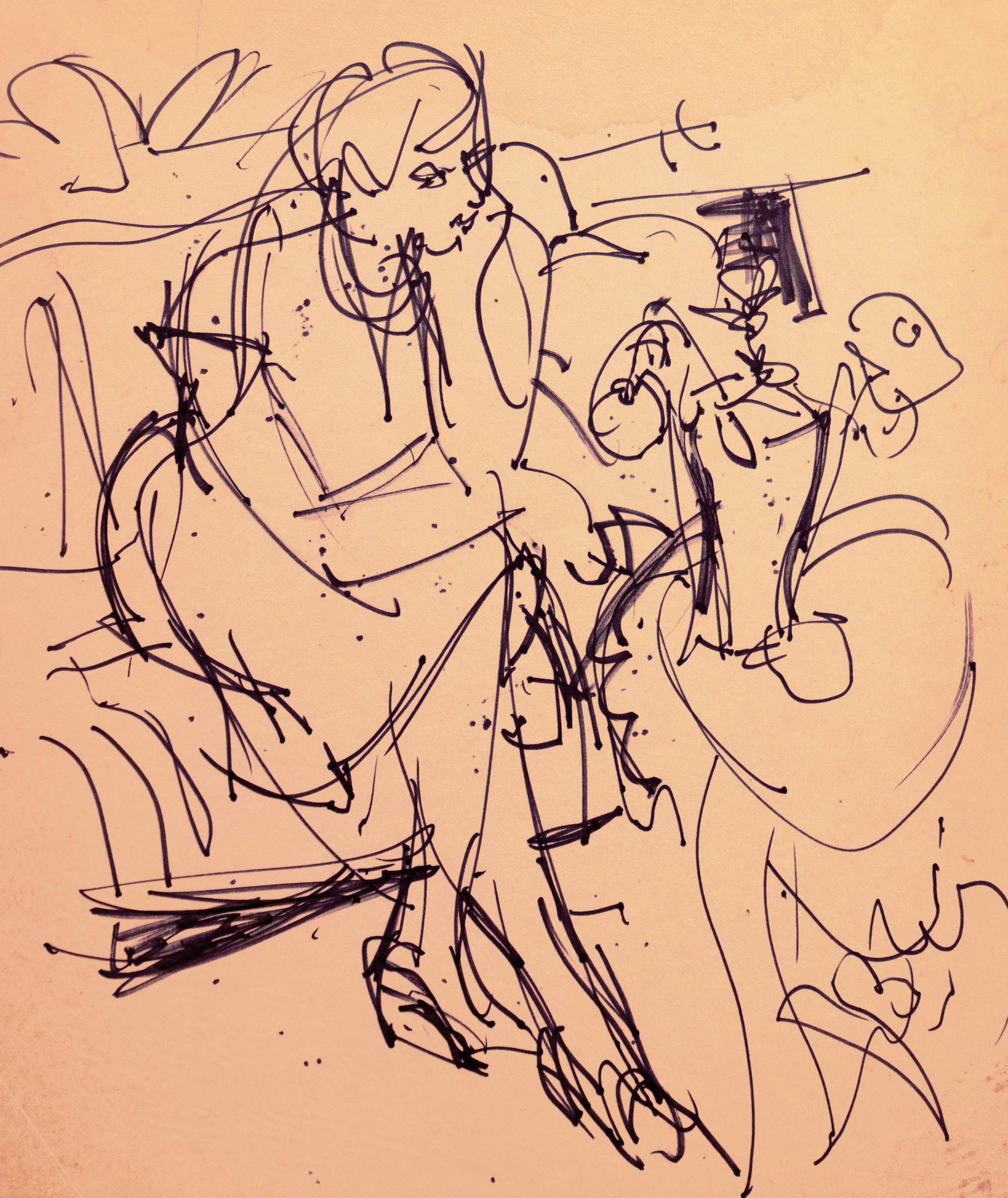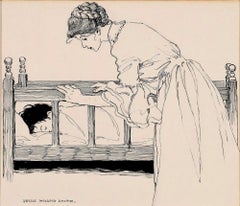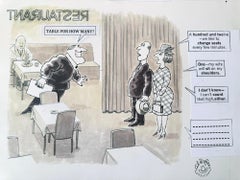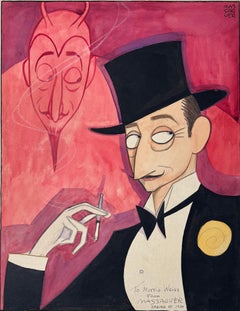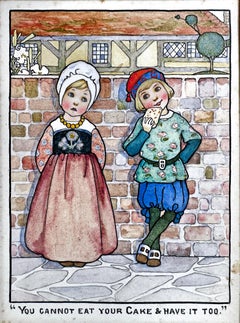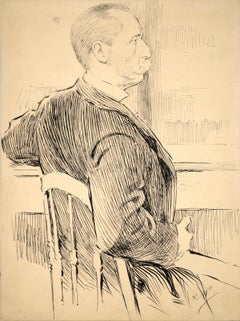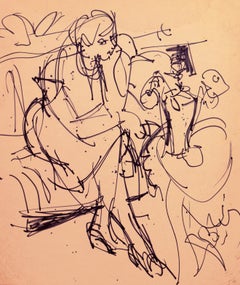Items Similar to Abstract Silhouette Hat Portraits - Female Illustrator of Golden Age
Want more images or videos?
Request additional images or videos from the seller
1 of 12
Jessie GillespieAbstract Silhouette Hat Portraits - Female Illustrator of Golden Age1910
1910
About the Item
115 years after they were created, one can view these silhouettes differently than the artist’s intent.
After all, the genesis of this work was an editorial illustration for Life Magazine to showcase elaborate women’s hats.
They were done for a commercial assignment with a deadline, and picky editors were overseeing the final work.
Today, they have a dual meaning.
These charming silhouettes are abstractions as much as they are representations.
Moreover, each one is a compact little gem stuffed with observational detail.
Golden Age female illustrator Jesse Gillespie's mastery of technical skill, is apparent in minute details and composition.
Young women, old women, pendants, necklaces, feathers, and laced vails all contribute to the works understated complexity.
The identity of the subjects are revealed by small areas of exposed neck and chin.
As the viewers eyes goes from left to right - all six silhouettes read as fashion hieroglyphs in a sentence with a visual rhythm and cadence. .
Initialed JG lower right., Matted but not framed.
Published: Life Magazine, March 17th, 1910.
Provenance: Honey and Wax Bookstore
________________________________
From Wikipedia, the free encyclopedia
Jessie Gillespie Willing (March 28, 1888 – August 1, 1972) was an American illustrator during the Golden Age of illustration. She was considered the foremost silhouette illustrator of her time, although she did traditional illustration as well. Willing illustrated for books and magazines including Life, The Ladies' Home Journal, Woman's Home Companion, Mother and Child, McClure's Magazine, Childhood Education, the Sunday Magazine, Association Men (the magazine of the YMCA), Farm and Fireside, Every Week, Children: The Magazine for Parents (which became Parents Magazine), and the American Magazine. She is perhaps most well known for her work for the Girl Scouts.
Early life
Willing was born in Brooklyn on March 28, 1888 to John Thomson Willing (August 4, 1860 – July 8, 1947)[1][2] and Charlotte Elizabeth Van Der Veer Willing (December 1, 1859 – March 4, 1930).[3] Thomson Willing was a noted illustrator and art editor. He was also well known for finding new artistic talent. Jessie Willing was the eldest of three children. Her brother Van Der Veer (November 30, 1889 – January 14, 1919), who died of pneumonia at the age of 29, was an advertising agent.[4] Her sister Elizabeth Hunnewell Willing (July 26, 1908 – August 15, 1991) was one of the first women to graduate from the Philadelphia Divinity School.[5][6] Elizabeth married the Rev. Orrin Judd, rector of St. Mary's Episcopal Church, on September 22, 1931, and was active in church work.[citation needed]
The Willing family moved to the Germantown neighborhood of Philadelphia in 1901 or 1902. Jessie Willing attended the Stevens School, from which she graduated in 1905. She then went on to attend the Philadelphia Academy of Fine Arts from 1906 to 1907.[7][8]
Career
Willing used her middle name Gillespie as her professional surname. She also often signed her illustrations J.G.[9] The story goes that the art editor of Life magazine was in Thomson Willing's office when he was the art editor of the Associated Sunday Magazine syndicate. Thomson Willing had some of Jessie's artwork on his desk, which the Life editor saw and admired. He asked for the artist's information so that he could give her freelance work. Thomson Willing did not want to be accused of nepotism so he persuaded Jessie to use Jessie Gillespie as her professional name, which she did.[10][11]
In addition to her extensive illustration work, Willing was also the editor of Heirlooms and Masterpieces from 1922 to 1931 and the art editor of Jewelers' Circular-Keystone from 1933 to 1939.[12] She specialized in jewelry publicity and advertising. In 1966 she won the Gold medal of the Printing Week Graphic Arts Exhibit in Philadelphia for her Christmas catalog for J.E. Caldwell Co., Philadelphia.
Willing was a member of the Plastic Club of Philadelphia,[13] the American Institute of Graphic Arts (AIGA) and the National Arts Club of New York.[14] She was an honorary life member of the National Arts Club[15] and served on its Board of Governors from 1941-1970. In 1963, she received the Gold Medal of the National Arts Club in recognition of 32 years of selfless devotion.[15] Additionally, she was the national director of the American Institute of Graphic Arts (AIGA) from 1943 to 1946.[15] Previous to this she served as the Program Chairman of the AIGA and in that position she put together a travelling exhibit on the "history of narrative art from the first recorded picture story to the comic book of the twentieth century."[16][17]
Illustrations in books
With Tongue and Pen--Frederick Bair, et al. (MacMillan, 1940)
Masoud the Bedouin--Alfred Post Carhart (Missionary Education Movement, 1915)
The Path of the Gopatis--Zilpha Carruthers (National Dairy Council, 1926)
The Schoolmaster and His Son: A Narrative of the Thirty Years War--Karl Heinrich Caspari (Lutheran Publication Society, 1917)
On a Rainy Day--Dorothy Canfield Fisher and Sarah Scott Fisher (A.S. Barnes and Co., 1938)
Book of Games for Home, School and Playground--William B. Forbush and Harry R Allen (John C. Winston, 1927)
Making Life Count--Eugene C. Foster (Interchurch Press, 1918)
Precious Books: Why and Where They are Treasured--Jessie Gillespie (A.T. Walraven Book Cover Co., 1933)
The Story of Little Goody Two-Shoes--(Grossett & Dunlap, 1944)
The Wisdom of Professor Happy, by the Professor Himself--Cliff Goldsmith (Child Health Organization of America, 1922)
Cho-Cho and the Health Fairy--Eleanor Glendower Griffith (MacMillan Co., 1922)
Travels of a Rolled Oat--Grace T. Hallock (Quaker Oats Co, 1929)
Grain Through the Ages--Grace T. Hallock (Quaker Oats Co., 1931)
A Flower of Monterey: A Romance of the Californias--Katherine B. Hamill (The Page Company, 1921)
Miss Gay's Adventures in First Aid, Series No. II: Artificial Respiration and the Need for Inhalators--Margaret Daly Hopkins (Hopkins Chart Co. 1936)
Ann of Ava--Ethel Daniels Hubbard (Missionary Education Movement, 1913)
The Moffats--Ethel Daniels Hubbard (Missionary Education Movement, 1917)
Spending the Day in China, Japan and the Philippines--Sally Lucas Jean and Grace T. Hallock (Harper and Brothers, 1932)
A Lovely Gate Set Wide: A Book of Catholic Verse for Young Readers--Sister Patrice Margaret (The Bruce Publishing Co., 1946)
The Pageant of Protestantism: Celebrating the Quadricentennial of the Reformation--Harriet Earhart Monroe (The Lutheran Publication Society, 1917)
Is this Tomorrow?--A. E. Osmond (Ernest Benn, 1949)
All Around the clock: Tales of Service and Sport--George Frederick Park (The Lutheran Publication Society, 1917)
Grif of Greenbrier Farm--George Frederick Park (The Lutheran Publication Society, 1917)
Everychild's Book Illustrated--Antoinette Rotan Peterson (MacMillan Company, 1922)
Rhymes of Cho Cho's Grandma--Mrs. Frederick Peterson (Children's Health Organization of America, 1920)
Living with the Family--Hazel Huston Price (Little, Brown and Co., 1942)
The Knight in Grey: A Historical Novel--Marie E. Richard (The Lutheran Publication Society, 1913)
The Honey Pot,Or, In the Garden of Lelita--Norval Richardson (L.C. Page & Co., 1912)
The Three Kings, translated from the German by Gustav Nieritz--Rebecca H. Schively (The Lutheran Publication Society)
The Singing Weaver and Other Stories--Julius and Margaret Seebach (The Lutheran Publication Society, 1917)
Other Peoples' Children--Margaret R. Seebach (The Lutheran Publication Society, 1914)
Soldier Silhouettes on our Front--William Le Roy Stidger (Scribner, 1918)
Star Dust from the Dugouts: A Reconstruction Book--William Le Roy Stidger (The Abingdon Press, 1919)
Health--C.E. Turner and Georgie B. Collins (D.C. Heath and Company, 1924)
The What-Shall-I-Do-Girl: Or, the Career of Joy Kent--Isabel Waitt (L.C. Page & Co., 1913)
The Birds' Christmas Carol--Mrs. Kate D. Wiggin (Houghton Mifflin Company, 1941)
The Pleasuring of Susan Smith--Helen Maria Winslow (Sir Isaac Pitman & Sons, 1912)
Illustrations appearing in Life magazine:
Adele--, A-Dell, “Adele!, July 9, 1914[18]
All, All are Gone, The Old Familiar Faces, April 7, 1910[19]
And I Sent Her Only a Christmas Card!, December 1, 1910[20]
At Any Matinee, April 15. 1909[21]
At the Afternoon Tea: ’The Ill-bred Line, August 1, 1912[22]
Baseball Term: “Perfect Control But No Speed, October 26, 1911[23]
Blessed Be the Tie That Binds, November 10, 1910[24]
Bride: Quick, John! There’s Another Grain!, March 17, 1910[25]
Bubble, Bubble, Toil and Trouble, June 15, 1911[26]
The Date Palm and the Rubber Plant, July 31, 1919[27]
Desperation, Inspiration, Anticipation, Realization, March 1, 1915[28]
The Difference Between Counter Irritants and Counter Attractions, September 8, 1910[29]
A Directoire Wash Day, March 11, 1909[30]
Dutch Treat, May 28, 1914[31]
Grandmothers, March 11, 1909[32]
Hark the Herald Angels Sing, December 7, 1911[33]
In the Hands of the Receiver, December 7, 1916[34]
January First: God Rest You, Merry Gentlemen. Let Nothing You Dismay, December 29, 1910[35]
A Jug of Wine and Thou, March 31, 1910[36]
The Land(ing) of the Free, December 15, 1910[37]
Metamorphosis, April 29, 1909[38]
Miss’ill Toe The Mark, December 7, 1911[39]
The Modern Pied Piper, March 24, 1910[40]
More Speed, Less Haste, January 6, 1910[41]
Needs Must When Fashion Drives, March 2, 1911[42]
Oh, the Difference Between Kissing a Miss, and Missing a Kiss!, December 25, 1913[43]
Oh, Woman in Your Hours of Ease, October 13, 1910[44]
Palms, March 31, 1910[45]
Peace on Earth, Good Will Toward Men, December 2, 1909[46]
The Right Kind of ‘Protection, September 7, 1911[47]
Sister! As Others See Us, April 7, 1910[48]
So Thoughtful of You—Just What I Wanted, December 2, 1909[49]
Some are Born Rich, Some Achieve Riches, and Some Have Riches Thrust Upon Them[50]
Styles for 1909: But Where Do We Come In?, December 3, 1908[51]
Syncopation, Desperation, Renunciation, Abnegation, Consummation But ----ation, August 31, 1916[52]
The Theatre Train, March 9, 1911[53]
’There was no room for them in the inn’.—St. Luke 2:7, December 2, 1915[54]
They Toil Not, Neither Do They Spin, March 3, 1910[55]
To Them That Hath, April 27, 1911[56]
Town and Country, May 6, 1909[57]
Trying Psycho-Physico Suggestion, September 22, 1910[58]
Valentines, February 2, 1911[59]
What Next? January 28. 1909[60]
The Woman Tempted Me and I Did Eat, March 23, 1911[61]
A Women’s Work is Never Done, November 26, 1908[62]
Illustrations in other magazines
"The Kindergarten and the Nursery School Movement"--Julia Wade Abbot (Mother and Child, February 1923)[63]
"Health Habits in the Kindergarten"--Julia Wade Abbot (Mother and Child, December 1921)[64]
"The Blue Store: A Bit of Business Magic"--Richard Bracefield (McClure's, July 1913)[65]
"Lucy and the Fairies"--Margaret Brearley (Childhood Education, September 1927)[66]
"Chicago, the Healthiest City"--Herman N. Bundesen (Chicago's Health, June 29. 1926)[67]
"Prevent Preventable Diseases"--Herman N. Bundesen (Chicago's Health, October 12, 1926).[68]
"Afternoon Tea at Washington"--Adele Steiner Burleson (Sunday Magazine, December 2, 1913)[69]
"The Gym or the 'Jimmies'"--Ellis Parker Butler (Association Men, September 1927)[70]
"The Thing You Want May Be Right at Your Elbow"--J.S. Cates (Farm and Fireside, November 1919)[71]
"Well, What's New in Your Line?"--James H. Collins (Every Week, March 2, 1918)[72]
"Does Your Farming Ever Take You Back to School?"--James H. Collins (Farm and Fireside, March
"The Child at the Christmas Play"--Jessie Collin (Ladies' Home Journal, December 1914)[74]
"Prohibition--And Your Farm"--William Harpter Dean (Fire and Fireside, July 1919)[75]
"The Comedy of Clothes"--Jessie Gillespie (Sunday Magazine, January 3, 1915)[76]
Cover Art--Jessie Gillespie (The Smart Set, March 1913)[77]
Cover Art--Jessie Gillespie (Sunday Magazine, February 4, 1912)[78]
Cover Art--Jessie Gillespie (Sunday Magazine, April 7, 1912)[79]
Cover Art--Jessie Gillespie (Association Men, December 1922)[80]
"Frontispiece"--Jessie Gillespie (Mother and Child, February 1923)[81]
"Panta=loons"--Jessie Gillespie (Sunday Magazine, October 25, 1914)[82]
"The Comic in Dress"--Grace Margaret Gould (Woman's Home Companion, March 1915)[83]
"The Deceitful Mirror"--Grace Margaret Gould (Woman's Home Companion, September 1913)[84]
"Good Lucks: After Vacation Comes Renovating Time for Faces"--Grace Margaret Gould (Woman's
Vogue Magazine Covers
- Creator:Jessie Gillespie (1888 - 1972, American)
- Creation Year:1910
- Dimensions:Height: 4.25 in (10.8 cm)Width: 20.5 in (52.07 cm)Depth: 1 in (2.54 cm)
- Medium:
- Movement & Style:
- Period:
- Condition:Good Condition: some light surface grime - lower right corner is broken but it's outside of the live area.
- Gallery Location:Miami, FL
- Reference Number:1stDibs: LU385313678792

About the Seller
4.9
Vetted Professional Seller
Every seller passes strict standards for authenticity and reliability
Established in 2005
1stDibs seller since 2016
113 sales on 1stDibs
Typical response time: <1 hour
- ShippingRetrieving quote...Shipping from: Miami, FL
- Return Policy
Authenticity Guarantee
In the unlikely event there’s an issue with an item’s authenticity, contact us within 1 year for a full refund. DetailsMoney-Back Guarantee
If your item is not as described, is damaged in transit, or does not arrive, contact us within 7 days for a full refund. Details24-Hour Cancellation
You have a 24-hour grace period in which to reconsider your purchase, with no questions asked.Vetted Professional Sellers
Our world-class sellers must adhere to strict standards for service and quality, maintaining the integrity of our listings.Price-Match Guarantee
If you find that a seller listed the same item for a lower price elsewhere, we’ll match it.Trusted Global Delivery
Our best-in-class carrier network provides specialized shipping options worldwide, including custom delivery.More From This Seller
View AllMother and Child, Golden Age of Illustration
By Jessie Willcox Smith
Located in Miami, FL
America's greatest female illustrator draws a heartwarming picture of a mother putting to bed her child. Motherly love towards their children is the artist's most iconic theme. This ...
Category
Early 1900s Art Nouveau Figurative Drawings and Watercolors
Materials
Ink, Illustration Board, Pen
Snappy Answers to Stupid Questions - Mad Magazine -Table for How Many Restaurant
Located in Miami, FL
"Snappy Answers to Stupid Questions" is one of Al Jaffee's signature series. This work was a double-page work that appeared on pages 60 - 61 in Mad Magazine in 1968. Although this w...
Category
1960s Conceptual Figurative Drawings and Watercolors
Materials
Ink, Gouache, Illustration Board, Pen
Cuban Artist - Caricature of Adolphe Menjou Debonair Devil
Located in Miami, FL
Framed Cuban Artist/Caricaturist Conrado Walter Massaguer presents Hollywood star Adolphe Menjou in a satirical dual portrait. In the foreground, the subject is seen in a dapper top hat, tux, fashionable cigarette and boutonnière, and is shown as being the epitome of being stylishly debonair. To make a larger point about this subject, Massaguer paints a cast shadow of Menjou as a burning red devil who studies his alter ego from above. Keeping with the artist's sarcasm, we see the good and bad in one image. Works by Massaguer are rare and this work is in keeping with his signature style. This work was most likely done on assignment for Life Magazine, Cosmopolitan, The New Yorker or Vanity Fair. Signed upper right. Inscribe lower right. Titled on verso. Unframed, Slight bend to board; toning to board; scattered faint foxing; pin point abrasions to margins, not affecting image. 19-1/2 x 15-1/8 inches board size.
Conrado Walter Massaguer y Diaz was a Cuban artist, political satirist, and magazine publisher. He is considered a student of the Art Nouveau. He was the first caricaturist in the world to broadcast his art on television.He was first caricaturist to exhibit on Fifth Avenue. He was the first caricaturist in the world to exhibit his caricatures on wood. He, and his brother Oscar, were the first magazine publishers in the world to use photolithographic printing.
Self portrait of Conrado Walter Massaguer, depicted on a carrousel ride, with the devil over his left shoulder and an angel over his right. (1945)
He created the magazine Social with his brother Oscar to showcase Cuban artistic talent. The duo later created the magazine Carteles, which became for a period the most popular magazine in Cuba, which was purchased by Miguel Ángel Quevedo in 1953.
In his life, he met and drew caricatures of Franklin D. Roosevelt, Walt Disney, Albert Einstein, the King of Spain, and many others.[ In sum total, he was the author of more than 28 thousand caricatures and drawings.Ernest Hemingway once had to refrain himself from punching Massaguer in the face after the artist drew an unflattering caricature of him. The dictator Gerardo Machado, however, did not punch Massaguer for his own unflattering caricature - he had the artist deported.
He was one of the most internationally renowned Cuban artists of his day, and his art is still regularly featured in galleries across the Western Hemisphere and Europe.
Early life
Massaguer was born on October 18, 1889, in Cárdenas, Cuba.[In 1892, his family moved to Havana.
When the Cuban War of Independence broke out, Massaguer's family escaped the country. From 1896 to 1908, he lived in Mérida, Mexico. However, during this time, his parents enrolled him in the New York Military Academy, where he stayed during school years.
In 1905, after graduating the military academy, he briefly attended the San Fernando school in Havana, where he was tutored by Ricardo de la Torriente and Leopoldo Romañach.
In 1906, less than a year later, he returned to the family home in Mexico.
Career as artist
Early career
While living in Yucatán, Mexico, Massaguer published his first caricatures in local newspapers and magazines. These included La Campana, La Arcadia, and the Diario Yucateco.
In 1908, he moved back to Havana. After returning to the island in 1908, Massaguer began mingling with Havana's aristocratic circles, forming close friendships with some of the city's most powerful and influential men, as well as winning the favor of many women who were quickly charmed by him. Massaguer, largely self-taught, honed his style using the avant-garde techniques he studied from the European and American magazines that were widely available in Cuba at the time.
Cover of the immensely popular Cuban magazine El Figaro, drawn by Massaguer in 1909. This cover depicts two bumbling, incompetent American tourists to the island.
He started drawing for El Fígaro, and was featured prominently on the cover in 1909.
After two years of refining his craft, Havana announced a poster contest aimed at attracting North American tourists to stay in the city during the winter months. Notable figures like Leopoldo Romañach, Armando Menocal, Rodríguez Morey, Jaime Valls, and others also entered the competition. The jury was particularly impressed by the modern execution and creative solution of one piece, signed by Massaguer, who was relatively unknown at the time.
The jury deliberations caused a great controversy.[5] The prize was ultimately awarded to the Galician painter Mariano Miguel, who had recently married the daughter of Nicolás Rivero, the wealthy owner of the conservative newspaper Diario de la Marina. Although Massaguer received only an honorable mention, the fraud scandal caused such an uproar that his name quickly entered the public spotlight, and he became an overnight sensation.
In 1910, he became co-owner of the advertising agency Mercurio, with Laureano Rodríguez Castells. At Mercurio, he led the Susini cigar campaign, and earned substantial wealth.
Massaguer has been described as a restless man, in both mind and body.After earning enough money from his art to begin traveling, he was almost always doing so. He constantly traveled between New York City and Havana, Mexico and France, Europe and the Americas.
In 1911, his reputation among the Havana socialites solidified when he organized his own first public caricature exhibit, and also the first Caricature Salon ever held in the Americas, hosted at Athenaeum of Havana (the Ateneo), and the Círculo de La Habana. Other exhibitors here included Maribona, Riverón, Portell Vilá, Valer, Botet, Barsó, García Cabrera, Carlos Fernández, Rafael Blanco, and Hamilton de Grau.
"Messaguer Visits Broadway." Caricatures of theatrical and literary figures. Elsie Janis, Raymond Hitchcock, S. Jay Kaufman (columnist), Ibanez, author of The Four Horsemen, and Frances White
In 1912, in the New York American Journal, he published his first Broadway drawings.
From 1913 to 1918, he was an editor for Gráfico.
Social
Main article: Social (magazine)
Cover of the magazine Social, July 7, 1923
In 1916, he created the magazine Social with his brother, Oscar H. Massaguer. Social's contributors included Guillén Carpentier, Chacón y Calvo, Enrique José Varona and others.Social has been described as Massaguer's great love in the magazine industry, and was the property that historians say he cared the most about. Social was an innovative magazine, being the first magazine in the world to use a modern printing process called photolithographic printing.
Social set cultural trends, not only in the fashion of Cuba, but in art, politics, and Cuban identity.[11] Social catered to a certain aesthetic in Cuba - that of the sophisticated elite socialite - but Massaguer would also use this magazine to ridicule and jibe against that same class of society when he found their personalities worthy of his contempt.
In Social, readers could find a variety of content, including short stories, avant-garde poetry, art reviews, philosophical essays, and serialized novels, as well as articles on interior design, haute couture, and fashion. Occasionally, the magazine also featured reports on sports such as motor racing, rowing, tennis, and horse riding.The cultural promotion efforts of both Massaguer and Emilio Roig de Leuchsenring are evident in the magazine. Notably, this period overlaps with their involvement in the Minorista Group, which was then at the forefront of the country's intellectual life.[5] Many contributors were devoted members of the group, leading some experts to consider Social as the cultural voice of the Minoristas.
One of the features of Social magazine was its section called "Massa Girls," which was a play on his own name, and pronounced with a glottal 'g' in a similar fashion to the letter in Massaguer.[12] Massaguer drew women as independent and free-thinking, and never drew the woman celebrity as a caricature of herself, but as a free agent surrounded by caricatures.[11] However, Massaguer himself has been described as a womanizer in his personal life, and hesitant to fully embrace every facet of women's liberation.
In 1916, he also established la Unión de Artes Gráficas and the advertising agency Kesevén Anuncios.[9]
The art critic Bernardo González Barroa wrote:
“Massaguer has solved the problem of working hard, living comfortably off what his art produces and not missing any artistic, sporting or social event. His broad, childish laugh, of a carefree individual who carries his luck hidden in a pocket, appears everywhere for the moment, disguising the pranks of pupils that lurk, mock and, finally, flash with satisfaction at finding the characteristic point after having analyzed a soul... Massaguer's personality is beginning to solidify now. He has been the best-known and most popular caricaturist for a long time, but his technique had not reached the security, the mastery of values that he presents in his latest works, which is very natural and explainable”[5]
Carteles
Main article: Carteles
Cover of the magazine Carteles, November 29, 1931
In 1919, Massaguer and his brother created the magazine Carteles.[9] Carteles gained the widest circulation of any magazine in Latin America, and the most popular magazine in Cuba for a time, until that title was claimed by Revista Bohemia. Carteles remained in print until July 1960.This magazine showcased Cuban commerce, art, sports, and social life before the revolution.
In 1924, Carteles took a more political turn, with articles criticizing Gerardo Machado's government. it became a prime example of the humor and graphic design employed by artists like Horacio Rodríguez Suria and Andrés García...
Category
1930s Art Nouveau Portrait Drawings and Watercolors
Materials
Watercolor, Ink, Illustration Board
The Wise Book Children's Book Illustration- Woman Illustrator - Arts and Crafts
Located in Miami, FL
This little gem of a compact artwork was executed in the Arts and Crafts style for an interior illustration for "The Wise Book," J.M. Dent & Co, London, 1906.
"You can't eat your ca...
Category
Early 1900s Victorian Figurative Drawings and Watercolors
Materials
Ink, Watercolor, Gouache, Board
Apocalypse, Catastrophic Destruction of the World, Surrealism - Life Magazine
Located in Miami, FL
Apocalypse in 1962? At the height of the Cold War, Life Magazine commissions an illustration that describes the world's end by means other than a nuclear war with Russia. Richard Erdoes brilliantly illustrates the work with his highly stylized painting technique. My favorite part of the work is on the left side showing a group of people packed together as they fall into oblivion. A clear reference would be Hieronymus Bosch's "The Last Judgment "
Once Again the World Ends." Illustration published in Life Magazine, Feb. 9, 1962
Signed in lower right image.
Unframed
Richard Erdoes (Hungarian Erdős, German Erdös; July 7, 1912 – July 16, 2008) was an American artist, photographer, illustrator and author.
Early life
Erdoes was born in Frankfurt,[1] to Maria Josefa Schrom on July 7, 1912. His father, Richárd Erdős Sr., was a Jewish Hungarian opera singer who had died a few weeks earlier in Budapest on June 9, 1912.[2] After his birth, his mother lived with her sister, the Viennese actress Leopoldine ("Poldi") Sangora,[3] He described himself as "equal parts Austrian, Hungarian and German, as well as equal parts Catholic, Protestant and Jew..."[4]
Career
He was a student at the Berlin Academy of Art in 1933, when Adolf Hitler came to power. He was involved in a small underground paper where he published anti-Hitler political cartoons which attracted the attention of the Nazi regime. He fled Germany with a price on his head. Back in Vienna, he continued his training at the Kunstgewerbeschule, now the University of Applied Arts, Vienna.[5] He also wrote and illustrated children's books and worked as a caricaturist for Tag and Stunde, anti-Nazi newspapers. After the Anschluss of Austria in 1938 he fled again, first to Paris, where he studied at the Academie de la Grande Chaumiere, and then London, England before journeying to the United States. He married his first wife, fellow artist Elsie Schulhof (d. xxxx) in London, shortly before their arrival in New York City.
In New York City, Erdoes enjoyed a long career as a commercial artist, and was known for his highly detailed, whimsical drawings. He created illustrations for such magazines as Stage, Fortune, Pageant, Gourmet, Harper's Bazaar, Sports Illustrated, The New York Times, Time, National Geographic and Life Magazine, where he met his second wife, Jean Sternbergh (d. 1995) who was an art director there. The couple married in 1951 and had three children.[6] Erdoes also illustrated many children's books.
An assignment for Life in 1967 took Erdoes to the Pine Ridge Indian Reservation for the first time, and marked the beginning of the work for which he would be best known. Erdoes was fascinated by Native American culture, outraged at the conditions on the reservation and deeply moved by the Civil Rights Movement that was raging at the time. He wrote histories, collections of Native American stories...
Category
1960s Surrealist Figurative Drawings and Watercolors
Materials
Mixed Media, Gouache, Board, Illustration Board
Glamour Fashion Portrait of Model Sara Thom - Mid Century
By Richard Stone
Located in Miami, FL
Dick Stone was a top mid-century illustrator who worked for the most famous brands. He was an assignment artist hired by such esteemed Ad Agencies as BBDO ...
Category
1950s Modern Portrait Drawings and Watercolors
Materials
Casein, Board, Pen
You May Also Like
19th C. Newspaper Illustration of Hiram H. Hobbs, Foreman of the Grand Jury 1898
Located in Soquel, CA
Historical late 19th century portrait of Hiram H. Hobbs, Foreman of the Grand Jury of San Francisco y Richard Langtry Partington (American, ...
Category
1890s American Impressionist Portrait Drawings and Watercolors
Materials
India Ink, Illustration Board
'Woman Seated', Paris, Louvre, Salon d'Automne, Académie Chaumière, LACMA, SFAA
By Victor Di Gesu
Located in Santa Cruz, CA
Stamped, verso, with estate stamp and estate wax seal for Victor Di Gesu (American, 1914-1988) and created circa 1955
Winner of the Prix Othon Friesz, Victor di Gesu first attended ...
Category
1950s Post-Impressionist Figurative Drawings and Watercolors
Materials
Board, Paper, Ink, Pen
1996: Gianluca Vialli - Juventus Captain in Rest.
Located in Firenze, IT
1996: Gianluca Vialli - Juventus Captain in Rest, Icon of Modern Myths
Technique: Charcoal on paper, signed and dated '96
Author: Marco Silombria (Savona, 1936 - Albissola, 2017) ...
Category
1990s Pop Art Portrait Drawings and Watercolors
Materials
Charcoal, Illustration Board
$465 Sale Price
20% Off
Juventus Football Player, UEFA Champions League Triumph, 1996. Cm 72 x 50
Located in Firenze, IT
Juventus Football Player, UEFA Champions League Triumph, 1996. Cm 72 x 50
Technique: Charcoal on paper, signed and dated '96
Author: Marco Silombria (Savona, 1936 - Albissola, 2017...
Category
Late 20th Century Pop Art Portrait Drawings and Watercolors
Materials
Paper, Charcoal, Illustration Board, Cardboard, Carbon Pencil
'Vancouver Girl', Young Woman with Bobbed Copper Hair, AIC, Paris, New York
Located in Santa Cruz, CA
Signed verso, 'George Wilburton Colby' (American, 1859-1922) and dated 1920.
George Colby was a member of the old Art League and a life member of the Chicago Art Institute. After hi...
Category
1920s Impressionist Figurative Drawings and Watercolors
Materials
Paper, Pastel, Illustration Board
Portrait of George Arliss in Conte Crayon on Cardstock 1934
Located in Soquel, CA
Stately portrait of George Arliss by Ivan Opffer (Danish, 1897-1980). Mr. Arliss is depicted wearing his signature monocle, looking directly at the viewer. Although this piece appears to be done rapidly, there is a clear confidence in Opffer's work - he was an accomplished portrait artist - and the resemblance to the subject is unmistakable. George Arliss (born Augustus George Andrews; 10 April 1868 – 5 February 1946) was an English actor, author, playwright, and filmmaker who found success in the United States. He was the first British actor to win an Academy Award – which he won for his performance as Victorian-era British prime minister Benjamin Disraeli in Disraeli (1929) – as well as the earliest-born actor to win the honour. He specialized in successful biopics, such as Disraeli, Voltaire (1933), and Cardinal Richelieu (1935), as well as light comedies, which included The Millionaire (1931) and A Successful Calamity (1932).
Signed and dated "Ivan Opffer 1934" in the lower right.
Titled "Mr. Arliss" in the lower left.
Presented in a new off-white mat with foamcore backing.
Mat size: 22"H x 16"W
Art size: 17.5"H x 12"W
Ivan Opffer (Danish, 1897-1980) was born in Nyborg, Denmark, on June 4, 1897, to a family of Danish scholars and journalists. His brother was Emil Opffer, a Danish merchant seaman and journalist who was known for his relationship with American writer Hart Crane.
Ivan was raised in Mexico City and New York, where his anarchist father was the editor of a radical Danish-language newspaper. His involvement in painting and drawing began at an early age. At a summer workshop, he met and studied drawing with Winslow Homer, then went on to study at the National Academy of Design and the Art Students League of New York.
When the US entered World War I, Opffer was one of the members of the American Army Camouflage Corps, headed by Homer Saint-Gaudens (whose mother was a relative of Winslow Homer), the son of Augustus Saint-Gaudens. As a camoufleur, Opffer served with other artists and architects, some of whom became well-known, including Barry Faulkner, Sherry Edmundson Fry, Kimon Nicolaides, Robert Lawson, Abraham Rattner, Kerr Eby, and others.
It was this same unit, while still in training in at Camp American University in Washington DC, that launched a camp newspaper called The Camoufleur. Only three issues were published before the unit’s deployment to France in late 1917. In the October 31 issue, a satirical portrait by Opffer of Homer Saint-Gaudens (titled “Our Boss”) was published on page 5.
After the war, Opffer returned to New York, where he became known for his caricatures of leading Modern writers, among them James Joyce, Edgar Lee Masters, Siegfried Sassoon, George Bernard Shaw, Carl Sandburg, G.K. Chesterton, and Thomas Mann.
In the years between the wars, Opffer married Betty à Beckett Chomley, and settled in Paris, where he was a student at the Academie Julliard. He also lived in London and Copenhagen, where his drawings were frequently published in newspapers and magazines. With the outbreak of World War II, he and his family returned to New York and lived in Greenwich Village.
Among his friends in that era were William Butler Yeats, F. Scott and Zelda Fitzgerald...
Category
1930s American Impressionist Portrait Drawings and Watercolors
Materials
Conté, Postcard, Illustration Board
$920 Sale Price
20% Off
Recently Viewed
View AllMore Ways To Browse
Silhouette Antique
Portraits Back Of Women
18c Portraits
1940s Illustration
Antique Silhouette Art
Golden Age Of Illustration
Silhouette Portrait
Portrait Of Mother And Child
Portrait Of Soldier
Antique Portrait Jewelry
Womens Hats
Abstract Female Portrait Painting
Victorian Antique Illustrations
Portrait George Washington
Portrait Of George Washington
Line Drawing Of Women
Portrait Of Woman 1970s
Antique Framed Silhouettes
